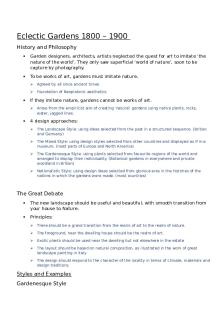Week 2 - Dunning’s eclectic paradigm PDF

| Title | Week 2 - Dunning’s eclectic paradigm |
|---|---|
| Author | Manuel Consuegra Gomis |
| Course | International Business Theory and Strategy |
| Institution | Manchester Metropolitan University |
| Pages | 2 |
| File Size | 117.9 KB |
| File Type | |
| Total Downloads | 87 |
| Total Views | 121 |
Summary
Lecture notes for the first week in the module of International Business Theory and Strategy, featuring: "Dunning’s eclectic paradigm"...
Description
Week 2 Dunning’s eclectic paradigm Lecture 2.1 – Overview
Three conditions determine whether or not a company will enter a given foreign country via FDI: o Ownership-specific advantages – knowledge, skills capabilities, relationships or physical assets a particular firm owns developed at home. Theories: - Monopolistic advantage theory based on the premise that MNEs prefer FDI as they will have control over resources and capabilities in the foreign market, and a degree of monopoly power relative to foreign competitors - Resources and capabilities – resource based VRIO Framework o Location-specific advantages – the specific advantages that exist in the country that the MNE has entered – natural resources, labour, policies - The theory of comparative advantages Porters Diamond model o Internalisation advantages – having control over a foreign based manufacturing, distribution and other value chain operations. Theories: - Internalisation theory – how the MNE chooses to acquire and retain one or more value chain activities inside itself greater control over foreign operations - Market imperfections theory
Lecture 2.2 – Ownership-specific advantages and Monopolistic advantage
Ownership-specific advantages explained first time by Hymer (1976) neoclassical theories couldn’t explain how foreign firms were successful in domestic markets - Foreign firms overcome the lack of experience and knowledge of the market with their own superior assets to compensate for this disadvantage - Monopolistic advantages are not available to local firms or they are superior to their existing assets
Apple and Tesla competitive advantages video: (strong resemblances) o Apple: - Pioneer in the smartphone market - Creation of a unique ecosystem for their users excellent compatibility with other apple devices - Loyal customer base - Production of differentiated products o Tesla: - Pioneer in the electric car market strong customer loyalty - Since they started from zero and they have had a fast evolution, it will make it difficult for other players to enter the market - Until others adapt allows the company to win a strong market share - Unique feature – Autopilot new feature with a learning machine from all the vehicles they produce the more miles, the more reliable - Branding and outstanding marketing making patents public to show that their objective is making human life sustainable + recognisable image of Elon Musk - Controlling entire supply chain - Production of differentiated products
Dynamic and sustained competitive advantage: o Systemic investigation of creating dynamic competitive advantage o Knowledge creation through research and development o Intellectual property rights must be strong in the country...
Similar Free PDFs

Paradigm Summaries
- 3 Pages

9.0 Eclectic Gardens
- 3 Pages

Week 2 - week 2
- 4 Pages

Week 2 - week 2
- 12 Pages

Week 2- Disscision - Week 2
- 1 Pages

Conjugate Reinforcement Paradigm
- 4 Pages

Goal Question Metric Paradigm
- 2 Pages

MCQs Paradigm Of - MCQ
- 13 Pages

Old Paradigm Chart
- 1 Pages

Week 2 quiz 511 - Week 2 Quiz
- 8 Pages

PSQF Week 2 Notes 2, Week 3
- 13 Pages
Popular Institutions
- Tinajero National High School - Annex
- Politeknik Caltex Riau
- Yokohama City University
- SGT University
- University of Al-Qadisiyah
- Divine Word College of Vigan
- Techniek College Rotterdam
- Universidade de Santiago
- Universiti Teknologi MARA Cawangan Johor Kampus Pasir Gudang
- Poltekkes Kemenkes Yogyakarta
- Baguio City National High School
- Colegio san marcos
- preparatoria uno
- Centro de Bachillerato Tecnológico Industrial y de Servicios No. 107
- Dalian Maritime University
- Quang Trung Secondary School
- Colegio Tecnológico en Informática
- Corporación Regional de Educación Superior
- Grupo CEDVA
- Dar Al Uloom University
- Centro de Estudios Preuniversitarios de la Universidad Nacional de Ingeniería
- 上智大学
- Aakash International School, Nuna Majara
- San Felipe Neri Catholic School
- Kang Chiao International School - New Taipei City
- Misamis Occidental National High School
- Institución Educativa Escuela Normal Juan Ladrilleros
- Kolehiyo ng Pantukan
- Batanes State College
- Instituto Continental
- Sekolah Menengah Kejuruan Kesehatan Kaltara (Tarakan)
- Colegio de La Inmaculada Concepcion - Cebu




